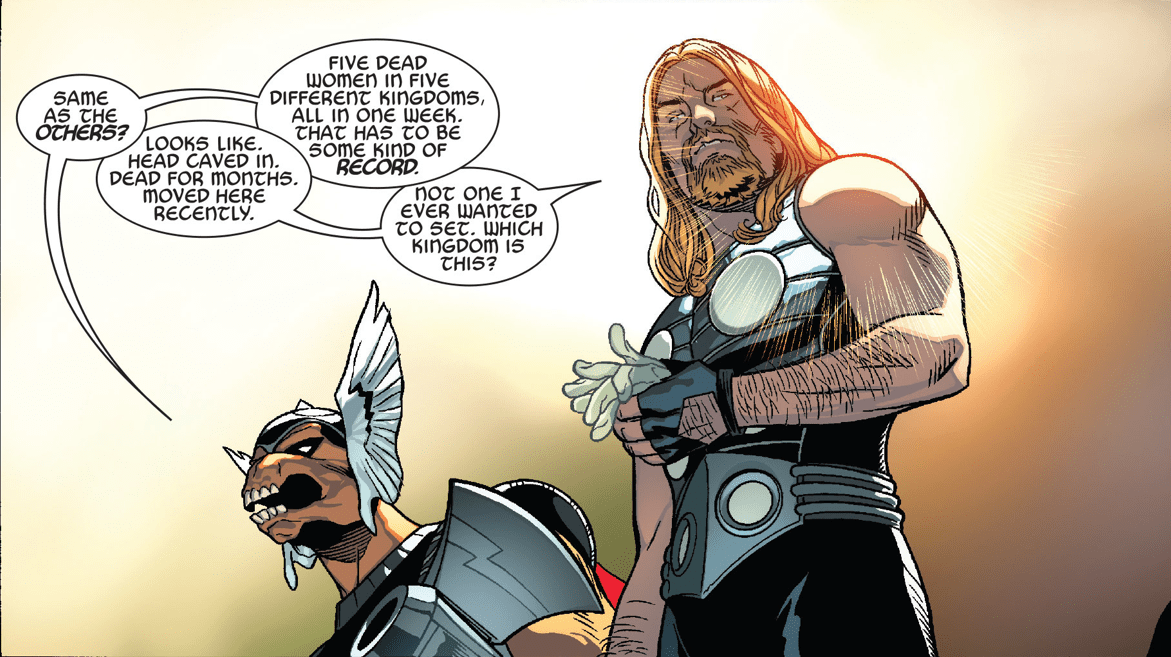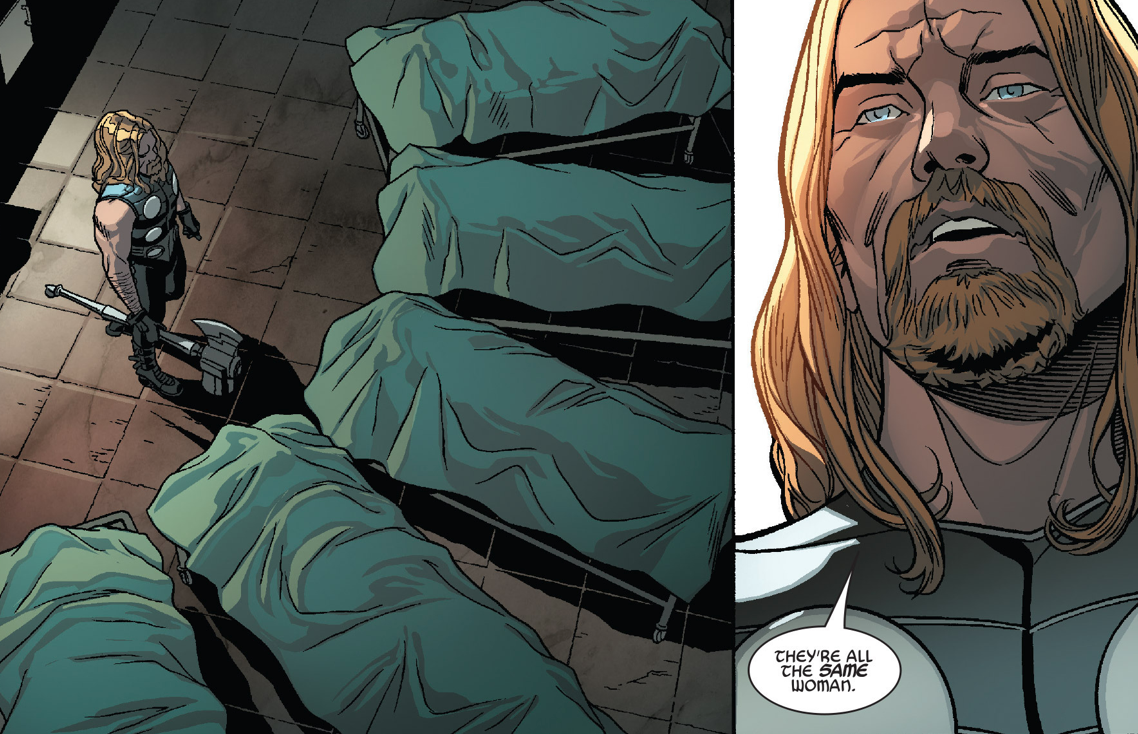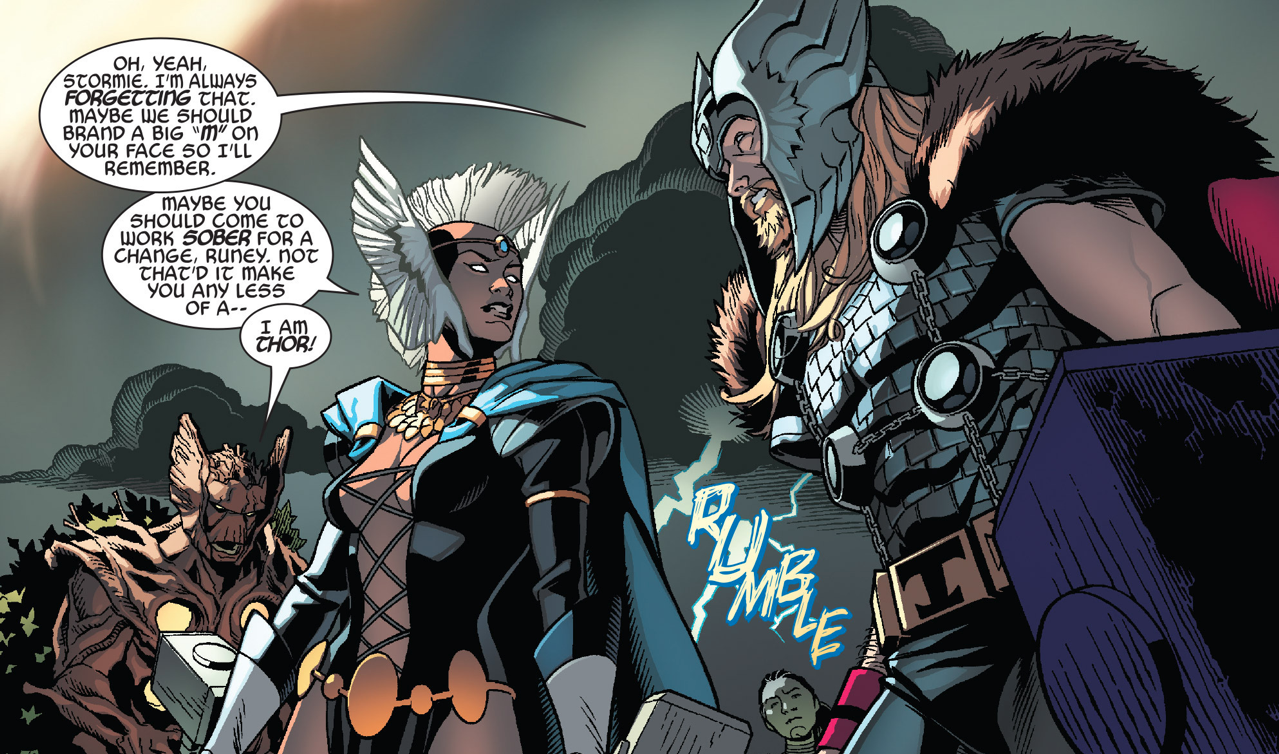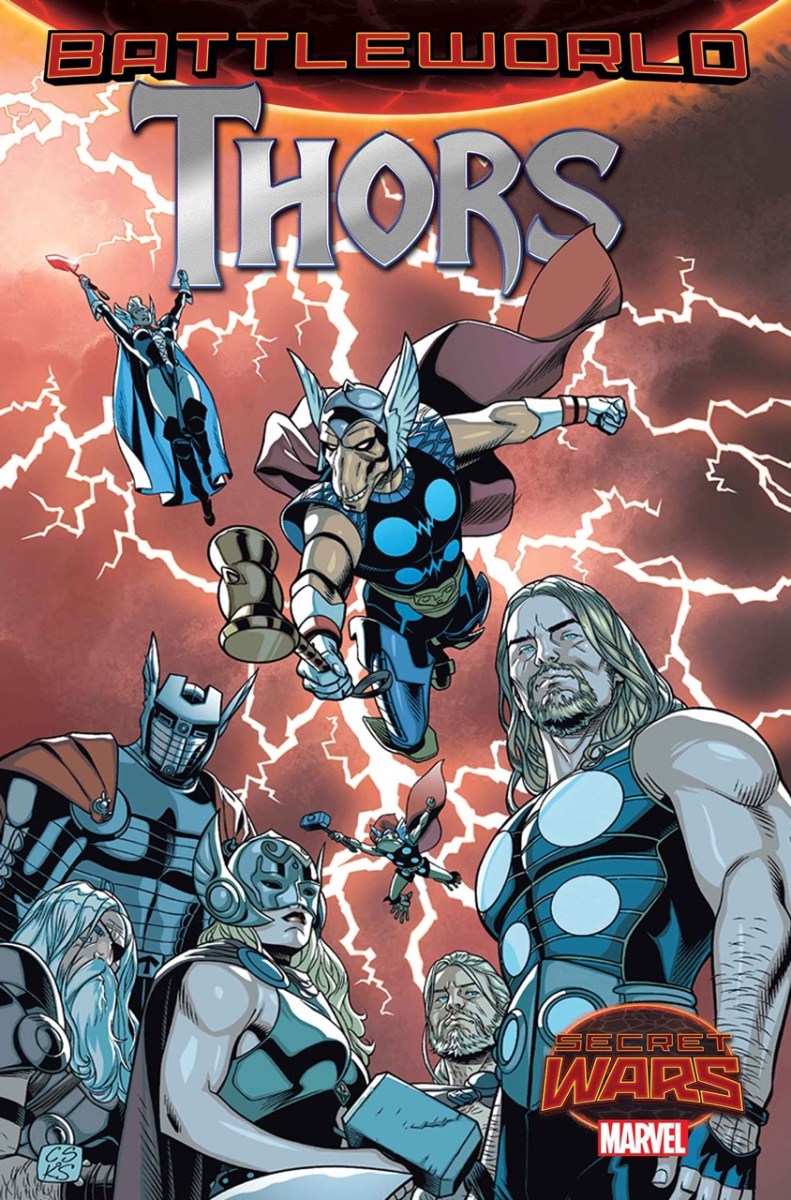Following the recent conclusion of Marvel’s Thor series, in which readers discovered that the secret identity of the new Goddess of Thunder was in fact , many fans of the series were eager to see where Thor would go next. Tying in with the Secret Wars event, series writer Jason Aaron returns with Thors #1 – a story meant to continue the threads of new!Thor’s heroic journey, but one that fails to be remotely as empowering as her solo series.
This post was originally published over on Rainbow Hub. It has been reposted here with permission.
Jason Aaron has made no secret of his love of detective and mystery stories, and his recent Marvel work – Thor and Original Sin – have been underpinned by their use of detective work, secret identities and whodunit logic to bring a sense of dramatic suspense to the punch-first-ask-questions-never world of superheroes. Thors attempts to take these elements to the next level with a fantastical spin on the crime procedural genre – think of it as CSI: Asgard, in which every cop carries their own hammer.
Focussing on the border guards that have a nasty habit of popping up in other Secret Wars series whenever someone needs banishing, the series follows the Battleworld’s finest as they walk their beats, solve crimes, and drink mead. When a string of grisly and unsolvable murders turn out to all feature the same woman – Jane Foster – as the mysterious victim, the Ultimate-Universe Thor and Beta Ray Bill have to crack the case in order to keep their hammers.

So let’s just address the most pressing concern of that recap: Jason Aaron decided to follow up the empowering story of Jane Foster becoming Thor and finding her place in both Asgardian and human society with a story that features her being murdered – repeatedly. Presumably the Goddess of Thunder featured in Thor will enter the story at a later point; but, so far, all we know is that someone is tracking down alternative universe versions of Jane Foster, brutally murdering them, and leaving their bodies to rot. How about that for inclusion?
At no point in this issue do we learn anything about any of these women as characters, about their lived experiences or their perspectives on these brutal crimes. Our empathy is never encouraged by the narrative to align with them. Instead, the focus surrounds the Ultimate-Thor, Thorlief (a coconut for anyone who can crack the naming conventions going on here), and his determination to solve this crime for pretty self-involved/white knight reasoning. There’s an incredibly half-hearted ‘we must find justice for these women’ speech that feels like it was directly lifted from an episode of an off-brand CSI imitator, but the major threat spotlighted is that Thorlief could lose his hammer (read as: Thor status/privilege) if he isn’t able to find the killer. To transition from Jane Foster being revealed as the Goddess of Thunder in Thor #8 to her maggot-infested corpse serving a clumsy plot device for threatened male entitlement within the space of a single issue goes beyond problematic – it’s baffling.
This is where Aaron’s use of the crime procedural format starts to smokescreen a lot of the plot and characterization issues in play. While it’s true that this storyline wouldn’t feel out of place in a show like CSI, that doesn’t give the creative team a free pass to replicate the associated gender and cultural biases that come along for the ride. The issue’s obsession with pastiche appears to have created a smokescreen effect for the sheer inappropriateness of the story. (This may well be why the image of five Jane Fosters in body bags wasn’t quite the canary in the coalmine moment it ought to have been for the editorial team.) The formulaic storyline of an innocent woman being brutally murdered and the hardboiled detective having to track down her killer in order to gain abstract justice isn’t just unimaginative – it reduces female characters to object status as men fight to protect or desecrate their bodies.

Just because crime procedurals regularly employ storylines like this doesn’t mean they’re good or interesting or respectful to ‘minority’ characters. At this stage of cultural saturation they’re just normalized, and so audiences have grown numbs to the shock of gratuitous female mutilation and excessive male violence dressed up as redemptive justice. Aaron’s use of this particular trope in such an unimaginative and predictable fashion is precisely what makes it so damaging: stripping Jane Foster of her legacy as a brave and meaningful character down to unknown victim in order to fit the cliché’s constraints upon women.
You can even view it as fridging taken to the logical extreme. If quintessential fridging sees male characters motivated by the death of female companions, then Thorlief’s quest for justice in the name of the poor, helpless female victims allows Aaron to skip the actual ‘have a somewhat-meaningful relationship with a female character’ part and jump straight to ‘She’s dead, Jim.’
A more imaginative use of this trope could have resulted in a much more engaging narrative which also continued Jane’s story in a way that maintained her strength and agency. While she’s just become the Goddess of Thunder, she’s also dealing with her cancer diagnosis (which is being aggravated by her heroic duties), and so her mortality is undoubtedly on her mind. Imagine if it was Jane Foster having to investigate a series of her own murders? Not only would that reassert her agency, but it would also offer opportunities for a more interesting detective-victim connection because, hey, they’re all the same person. There were other ways to tell this story without taking feminism out into the woods and cracking it over the head with a shovel.
And while Aaron’s use of this cliché might have been less explicit in isolation, the issue’s compounding of crime procedural stereotypes proves equally uncomfortable. Loki features as a homeless madman informant of Beta Ray Bill’s – ticking the ‘eccentric hobo who helps them crack the case’ trope. Storm features as the only female Thor in the entire issue. (Did someone say ‘token’?) Not only does she suffer verbal abuse from an older Thor (‘drunken and grizzled detective who doesn’t play by the rules!’) who argues she should be facially branded to remind everyone she’s a mutant, but also has to put up with Thorlief hitting on her while at work? She’s also dressed in a shoe-string swimming costume outfit with a headdress that looks like a Thanksgiving turkey at Coachella, it’s all very bad.

The only glimmer of joy within the entire issue is when Throg cameos as the Thor Corps’ resident forensic pathologist; but so many terrible crime clichés are trotted out in succession that Thors #1 feels like it’s in danger of buckling under its lack of self-awareness. By themselves, each of these tropes has the potential to be interesting or rewarding if they were engaged with in an original way (except the homeless informant one, bin that.) Instead, the one-note translation of them – complete with their racist, sexist, and privileged biases unscathed – proves to be utterly unrewarding for the reader.
After all the goodwill earned with readers by Thor and its exploration of Jane Foster’s taking on of the heroic mantle, Jason Aaron decides to progress this story by murdering multiple alternate versions of the character in gruesome, anonymous ways and tasking an upstanding man with saving her living counterparts in order to save his own privilege. I am a great admirer of Aaron’s work, but the use of lazy tropes to transform iconic, progressive characters like Jane Foster, Loki, and Storm into fundamentally inappropriate, one-dimensional characters is a massive step backwards for a series that follows on from Thor.
Perhaps the most systemic issue of this series (and Marvel’s publishing strategy as a whole) is precisely how newer readers are meant to navigate this tonal change. For ‘alternative’ comic fans that got involved with the series following the introduction of the Goddess of Thunder, Secret Wars might not mean a lot, but a new Thor series on shelves by the same writer would most likely seem to be a safe bet. Just imagine discovering and loving an empowering, resilient determined hero like Jane Foster as Thor, only to then see her be brutally murdered and replaced with (for all intents and purposes to new readers) the ‘original’ Thor again. While the Jane Foster that readers have followed in Thor is alive in Secret Wars (following the events of the main series), how on earth are people that only want to read her adventures supposed to know that?
Marvel’s massive diversity push has been a great success in its initial stages (Spider-Butt aside), but now that the publisher has a number of imaginative, diverse, and rewarding female series running, the question is how to successfully merge these with the rest of the publishing line. It’s all well and good to create safe spaces for alternative readers in books like Thor or Ms. Marvel, but if you then progress these characters by placing them in situations where they’re treated as badly as female comic characters have been historically (murdered, mutilated, sexually harassed etc.) then you’re not championing inclusion at all. We’ve got our safe spaces, Marvel; but why is the rest of your world still so dangerous?
Adam Sorice is a literate graduate turned grown-up who writes about pop culture when he’s not describing himself in the third person. His writing engages with all the key feminist icons of our time: Lady Gaga, Sailor Moon, Elsa from Frozen and, naturally, Thor. To read more of his work, check out his blog or follow him on Twitter.
—Please make note of The Mary Sue’s general comment policy.—
Do you follow The Mary Sue on Twitter, Facebook, Tumblr, Pinterest, & Google +?









Published: Jun 21, 2015 02:00 pm